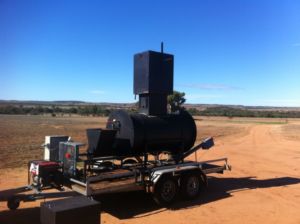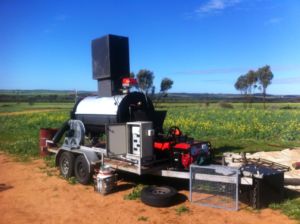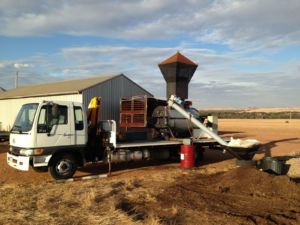Building a Biochar Kiln – Lessons Learnt
Drivers
Firstly, we were engaged by Chandala Poultry to design a system that would recover the energy from chicken litter the farm produces and use it to meet the farms energy requirements. We did look at other bioenergy technologies including anaerobic digestion but decided, after consultation with the owner, on pyrolysis.
Secondly, technologies to produce biochar in Australia are either too big, needing thousands of tonnes of feedstock to be viable and a very high capital expenditure or the smaller, cheaper technologies, a little underdeveloped.
The final and key driver to start building a biochar kiln was that we wanted to demonstrate bioenergy technology to farmers. We believe that bioenergy and the valuable byproducts produced by the process complements agriculture and closes the nutrient loop. Most farmers have not had the opportunity to visit a bioenergy plant so we decided to bring bioenergy to farmers.
Beginning the process

After making the decision to begin building a biochar kiln, we sourced a design that would meet our requirements:
- Simple and user friendly
- Affordable
- Continuous flow
- Able to be made mobile for demonstration purposes.
We then contacted various Geraldton based (trying to keep it local) firms capable of building a biochar kiln and asked them to quote on materials and some construction work. It was our aim to get the components built and do most of the construction of the biochar kiln ourselves, this way we get to know the machine inside and out.
In the beginning of 2013 we started building the biochar kiln and after some testing quickly found a few issues that needed to be addressed. These included:
Maintaining heat
It is critical to be able to maintain heat inside the biochar kiln for the pyrolysis process to take place. In the beginning, we used minimal insulation and because of this we were losing a lot of process heat. After we addressed this problem we were able to get to operating temperature quickly and maintain the temperature where it was needed, inside the pyrolysis chamber.
Gas vs diesel

Initially we were using LPG gas to heat the biochar kiln however, after looking at the issues and regulations associated with using gas, we decided to use a burner fired on diesel to provide the heat needed to get the process going. We find it easier to manage logistically, just as efficient and a lot safer to operate.
Course material
As we are using augers to move the feedstock into and through the biochar kiln, unless it is ground quite fine we can have some issues, the longer pieces wrap around the auger shafts and can block the auger. This necessitated purchasing a tub grinder which we will use to grind organic materials like wheat straw and wood chips.
Moisture content
Feedstock moisture content is also very important. If the moisture is too high then the process does not work and we have to use a lot of energy just to dry the material to a point when it will char. This is inefficient and not what we are trying to achieve. The ideal environment for the biochar kiln is to use an external heat source to heat the chamber then be able to turn it off and rely on the incoming material to provide the energy necessary to maintain the process, this is renewable energy.
This particular problem meant we had to come up with a way to dry the material before we processed it. After long debate we designed and engineered an internal drying system. The dryer is an auger we have installed inside the kiln above the pyrolysis zone. We load the material via a loading auger which feeds into the dryer where it moves along very slowly. The moisture is driven off by the heat produced by the biochar kiln as it moves through the dryer.When it reaches the end of the drying auger the material drops out into the pyrolysis auger.
This auger completes the biochar process, gases bound up n the material are released as the material turns to biochar. These gases are then combusted in the gasification zone to create heat.
Where are we now?

Since the upgrade last month we have run the kiln a few times but like anything new, we have had a few teething problems. Namely, with heat expansion and some manufacturing issues with the drying auger. We believe we have sorted out these issues and are looking forward to testing the process again soon.
Stay tuned for updates or contact us to learn more.

